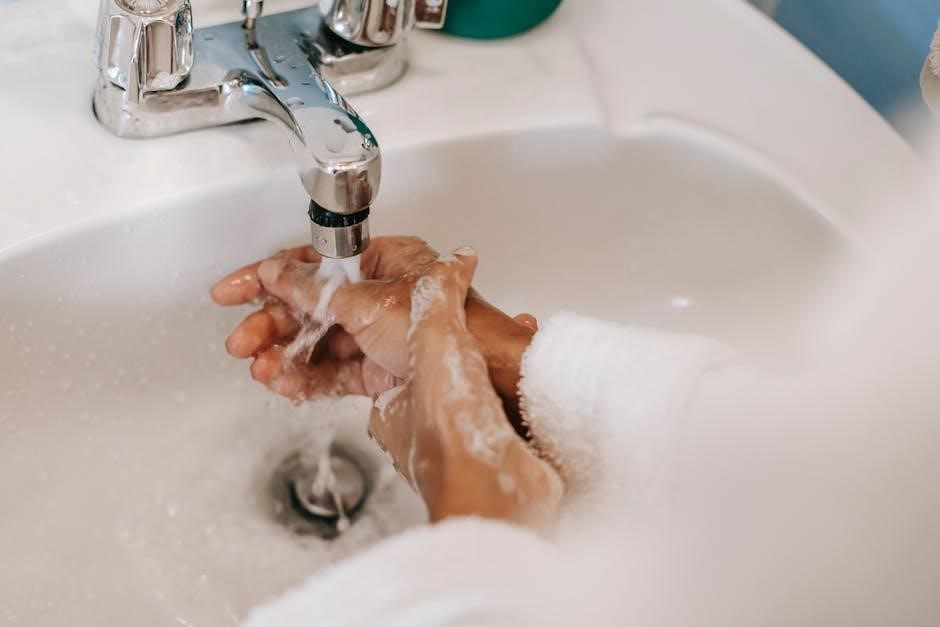Welcome to the Home Health Care Agency Policy and Procedure Manual, designed to guide operations, ensure compliance, and maintain high standards of patient care and operational integrity.
1.1 Overview
This manual serves as a foundational document for home health care agencies, outlining essential policies, procedures, and guidelines to ensure efficient operations. It provides a comprehensive framework for delivering high-quality patient care while maintaining regulatory compliance. The manual covers key aspects of agency management, including staffing, patient intake, clinical practices, and quality assurance. Designed to be adaptable, it offers customizable templates and tools to meet the unique needs of individual agencies. By adhering to the principles outlined in this document, organizations can ensure consistency, accountability, and excellence in service delivery. This overview highlights the importance of having a structured approach to managing a home health care agency effectively.
1.2 Purpose
The primary purpose of this manual is to establish clear guidelines and standards for home health care agencies to ensure consistent, high-quality care. It serves as a reference for staff, outlining expectations and best practices in patient care, administrative processes, and regulatory compliance. By providing a structured framework, the manual aims to enhance operational efficiency, reduce risks, and improve patient outcomes. It also ensures that all services are delivered in accordance with federal and state regulations, maintaining the agency’s credibility and integrity. This document is essential for training new employees and reinforcing standards among existing staff, fostering a culture of accountability and excellence within the organization. Ultimately, the manual supports the agency’s mission to provide compassionate, effective, and patient-centered care in the home setting.

Development Process of the Manual
The manual was developed by experts, incorporating industry best practices and regulatory requirements to ensure comprehensive and adaptable policies for home health care agencies.
2.1 Steps to Create the Manual
Creating a home health care agency policy and procedure manual involves several key steps. First, identify the agency’s specific needs and goals. Next, gather all relevant federal, state, and local regulations to ensure compliance. Utilize existing templates or consult with legal and healthcare professionals to draft policies. Include sections on staffing, patient intake, clinical procedures, and risk management. Ensure each policy is clear, concise, and actionable. Review and revise the manual regularly to reflect changes in laws, best practices, and agency operations. Finally, implement the manual across the organization, providing training to all staff to ensure understanding and adherence.
2.2 Tools and Templates Available
Several tools and templates are available to assist in creating a comprehensive home health care agency policy and procedure manual. CMS provides template examples that meet federal requirements, while state-specific resources offer guidance for local compliance. Editable templates in MS Word format allow customization to fit agency needs. Additionally, professional consulting services can provide tailored solutions. Many home care agencies utilize pre-designed templates from reputable sources, such as the National Association for Home Care & Hospice. These tools often include sections for staffing, patient intake, clinical procedures, and risk management. Utilizing these resources ensures the manual is thorough, compliant, and adaptable to the agency’s specific operations. Regular updates and revisions are also supported by these tools, maintaining relevance and effectiveness.

Administrative Policies
Administrative policies outline the operational guidelines for managing the home health care agency, covering staffing, training, patient intake, and compliance with federal and state regulations.
3.1 Staffing and Training Requirements
Staffing and training requirements ensure that all home health care personnel are qualified and prepared to deliver high-quality patient care. Agencies must establish clear hiring criteria, including background checks, certifications, and licensing. Ongoing training programs are essential to keep staff updated on best practices, regulatory changes, and patient care advancements. Training should cover infection control, emergency response, and confidentiality protocols. Additionally, supervisors must monitor staff performance and provide feedback to ensure compliance with agency policies and industry standards. Regular competency assessments and continuing education opportunities help maintain a skilled and knowledgeable workforce, ultimately enhancing patient outcomes and agency effectiveness.
3.2 Patient Intake and Admission Criteria
Patient intake and admission criteria are critical to ensure that home health care services are provided to eligible individuals who can benefit from the care offered. The agency must establish clear guidelines for accepting patients, including medical necessity, insurance coverage, and the ability to receive care in a home setting. A comprehensive assessment is conducted during intake to evaluate the patient’s medical condition, functional abilities, and environmental factors. Documentation of this process ensures compliance with regulatory requirements and facilitates smooth transitions into care. Admission decisions are made based on the agency’s capacity to meet the patient’s specific needs and the availability of qualified staff. Effective communication with patients and families during intake helps set expectations and promotes a positive care experience.

Clinical Procedures
This section outlines the development and implementation of evidence-based clinical protocols to ensure safe, effective, patient-centered care delivery in home health settings, adhering to regulatory standards.
4.1 Developing Individualized Care Plans
Creating individualized care plans is essential for delivering personalized and effective home health care. These plans are tailored to address each patient’s unique medical, emotional, and social needs. The process begins with a comprehensive assessment of the patient’s condition, including input from healthcare providers, family members, and the patient themselves. Goals and interventions are established based on the assessment, ensuring a patient-centered approach. The care plan is regularly reviewed and updated to reflect progress, changes in condition, or new requirements. Collaboration among interdisciplinary teams is crucial to ensure continuity of care. Documentation of the care plan must comply with regulatory standards, such as those set by CMS, to maintain accountability and quality. This structured approach ensures that care remains focused, measurable, and aligned with the patient’s overall well-being.
4.2 Medication Management Protocols
Medication management is a critical component of home health care, ensuring patient safety and adherence to prescribed treatments. Protocols are established to guide staff in accurately administering, monitoring, and documenting medications. These protocols emphasize the importance of verifying medication lists, dosages, and frequencies to prevent errors. Staff are trained to observe for adverse reactions and report concerns promptly. Patient and caregiver education is integral, ensuring understanding of medication purposes, side effects, and proper administration techniques. Documentation must be thorough, including records of administered medications and any changes. Regular audits are conducted to ensure compliance with CMS and state-specific regulations. These protocols aim to minimize risks, enhance patient outcomes, and maintain high standards of care delivery in the home health setting.

Regulatory Compliance
Regulatory compliance ensures adherence to federal and state laws, including CMS requirements, maintaining ethical standards, and conducting regular audits to guarantee operational integrity and patient safety.
5.1 Federal Regulations Overview
Federal regulations for home health care agencies are established by the Centers for Medicare & Medicaid Services (CMS) and include standards for patient care, documentation, and operational practices. These regulations ensure that agencies provide high-quality, patient-centered care while maintaining compliance with legal requirements. Key areas of focus include patient rights, privacy protections under HIPAA, and adherence to the Affordable Care Act. Agencies must also comply with federal labor laws and workplace safety standards set by OSHA. Regular audits and inspections are conducted to verify compliance, and failure to meet these standards can result in penalties or loss of certification. Staying informed about updates to federal regulations is essential for maintaining compliance and delivering optimal care.
5.2 State-Specific Compliance Requirements
State-specific compliance requirements for home health care agencies vary by jurisdiction and must be carefully followed to ensure operational legality. Many states require agencies to obtain specific licenses or certifications, often involving detailed applications and periodic renewals. Additionally, state laws may dictate staffing ratios, background check procedures, and training standards for caregivers. Some states impose additional requirements for patient documentation, billing practices, and infection control protocols. Agencies must also adhere to state-specific privacy laws that may exceed federal HIPAA standards. Regular reviews of state health department guidelines are essential to maintain compliance and avoid penalties. Tailoring policies to meet individual state regulations ensures that agencies can operate effectively while providing high-quality care tailored to local needs and expectations.

Quality Assurance
Quality Assurance ensures monitoring processes, evaluating outcomes, and implementing corrective actions to maintain high standards of care and patient safety in home health services.
6.1 Monitoring and Evaluation Methods
Monitoring and evaluation are critical components of quality assurance, ensuring continuous improvement in home health care services. These processes involve systematic data collection and analysis to assess adherence to policies, patient outcomes, and operational efficiency. Regular audits, performance assessments, and feedback mechanisms are employed to identify gaps and implement corrective actions. The agency utilizes standardized tools and metrics to measure care quality, patient satisfaction, and compliance with regulatory standards. Evaluation findings guide strategic decisions, fostering a culture of accountability and excellence. By integrating monitoring and evaluation into daily operations, the agency ensures that care delivery aligns with best practices and patient needs, ultimately enhancing overall service quality and patient well-being.

Patient Rights and Responsibilities
Patient rights and responsibilities are fundamental to the delivery of high-quality home health care services. Patients have the right to receive respectful, dignified, and compassionate care, free from discrimination or abuse. They are entitled to privacy and confidentiality of their medical information, as outlined by federal and state regulations. Patients also have the right to be fully informed about their diagnosis, treatment options, and prognosis, enabling them to make informed decisions about their care. Additionally, patients have the responsibility to provide accurate health information, adhere to treatment plans, and communicate openly with their caregivers. Understanding these rights and responsibilities fosters trust and collaboration between patients and healthcare providers, ensuring a patient-centered approach to care delivery.

Risk Management
Risk management is a critical component of home health care operations, ensuring the identification, assessment, and mitigation of potential risks. This process aims to protect patients, staff, and the agency from adverse events, legal liabilities, and financial losses. Effective risk management involves regular audits, incident reporting mechanisms, and staff training to address safety protocols and compliance with regulations. Agencies must implement strategies to minimize risks related to patient care, employee misconduct, and operational inefficiencies. By fostering a culture of safety and accountability, home health care providers can reduce hazards and enhance overall service quality. A comprehensive risk management plan ensures that the agency operates within legal and ethical standards while safeguarding its reputation and continuity of care.

Implementation and Updates
Effective implementation of the manual requires staff training and clear communication. Regular updates ensure compliance with evolving regulations and industry standards, maintaining operational efficiency and quality care.
9.1 Effective Implementation Strategies
To ensure successful adoption of the policy and procedure manual, agencies should employ structured implementation strategies. This includes conducting comprehensive staff training programs, fostering open communication, and assigning accountability to key personnel. Leadership should champion the initiative, promoting a culture of adherence and continuous improvement. Regular progress monitoring and feedback sessions can help identify gaps and address challenges promptly. Additionally, aligning the manual with the agency’s mission and values enhances buy-in from all stakeholders. By integrating these strategies, home health care agencies can effectively operationalize their policies and procedures, ensuring compliance, consistency, and high-quality patient care. Clear communication and ongoing support are essential for sustained success and adaptation to evolving industry standards.

9.2 Regular Updates and Revisions
Regular updates and revisions are crucial to maintain the relevance and effectiveness of the policy and procedure manual. Agencies should establish a systematic process for reviewing and updating the manual annually or as needed. This ensures compliance with evolving federal and state regulations, accreditation standards, and industry best practices. Updates should be based on feedback from staff, changes in patient care needs, and advancements in healthcare delivery. A designated team or committee should oversee the revision process, ensuring that all changes are thoroughly reviewed, approved, and communicated to all stakeholders. Training sessions or updates should be provided to staff to familiarize them with new policies and procedures. Archives of previous versions should be maintained for reference and compliance purposes. This proactive approach ensures the manual remains a dynamic and invaluable resource for the agency’s operations.
